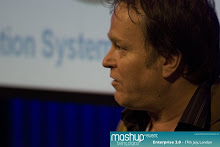This morning I watched Dr. Stuart Brown talking about the importance of play. He makes a number of compelling points about the role of play in the development of trust, innovation and social interaction. More specifically, Dr. Brown reminds us that stories and storytelling provide "the unit of intelligibility in our brains" (how we make-sense of stuff).
Dr. Stuart Brown: "The basis of human trust is through play-signals"
This reminded me of an article I wrote for IASA where I talk about my experience of importance of storytelling skills to Enterprise Architects. Here's a couple of things I said:
"Enterprise Architects should be convincing and credible storytellers....We architects must learn to become comfortable with the journalists’ technique of ‘Simplifying and Exaggerating’. It’s much more important to convey a highly simplified message about a complex problem to the business stakeholders than it is to demonstrate our grasp of the complex and the obscure. We must become proud of our ability to distill and communicate the important opportunities – and the barriers to change.”
and
“Cartoons and other visual media are a powerful way of communicating often quite complex, and sometimes contentious issues, simply".
Building on the value of play and storytelling in communicating sophisticated ideas, another TED video from Scott McCloud got me thinking more about the value of comics & cartoons.
Architects are comfortable with the idea of creating visual maps and blueprints. They seem less inclined, however, to see the value in 'less scientific' visual expressions. Scott McCloud does a great job of resolving this science v. arts discomfort. He uses a number of phrases that rung-a-IS-architecture-bell for me – he talks about “watching for patterns” and explains the journey from "visual iconography to language" and creating “temporal maps” - this is the stuff of IS architecture.
Finally, he talks about creating “durable mutations” of the comic medium that create window's back into our world. And as these mutations develop they will “provide people with multiple ways of re-entering the world through different windows and when they do that it allows them to triangulate the world that the live in and see its shape".
Could one of these “durable mutations” be a new way to express Enterprise Architecture to 'the business'? And is this idea more generally applicable to how we communicate our values and build trust - independent of practice or discipline?





1 comment:
Great post Nigel.
There is often talk about the importance of 'soft' skills, but usually in a nebulous sense. This thinking flips things around to place communication at the heart of matters, which, as you say, it surely is.
Post a Comment